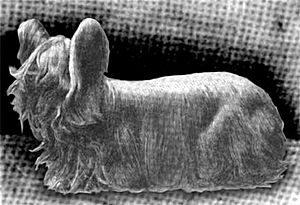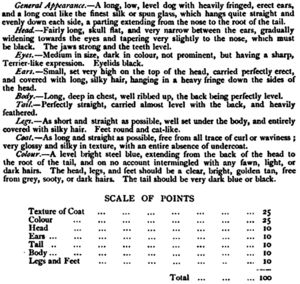Paisley Terrier facts for kids

A Paisley Terrier in 1903
|
|
| Other names | Clydesdale Terrier |
|---|---|
| Common nicknames | Silky |
| Origin | Scotland |
| Breed status | Extinct |
| Domestic dog (Canis lupus familiaris) | |
The Paisley Terrier was a type of dog that doesn't exist anymore. It was a small, furry dog from Scotland. People mainly bred these dogs to be pets and to show them off in dog shows. The Paisley Terrier was like a fancy version of the Skye Terrier. It's also super important because it was the main ancestor of the Yorkshire Terrier we know today!
This dog was named the Paisley Terrier because many of them came from a place called Paisley, Renfrewshire. It was also sometimes called the Clydesdale Terrier, after another area in the Clyde Valley where these dogs were bred.
Contents
What Did the Paisley Terrier Look Like?
The Paisley Terrier looked a lot like the Skye Terrier. However, it had a shorter back. It also weighed less, usually around 7 kilograms (about 16 pounds). That's about half the weight of a Skye Terrier today!
These dogs had a beautiful, flowing coat. It was described as a "silvery, soft jacket" with colors of blue and tan. Their fur was very silky, especially the long hair on their ears. Because of its soft, silky fur, people often called it the Silky.
Even from the very beginning, the Paisley Terrier's beautiful coat won many awards at dog shows. To show off their long, silky fur, these dogs were often displayed standing on a special box.
In the late 1800s, people said the Paisley Terrier was a great house dog. It was perfect for someone who wanted a pet that was a bit bigger than a tiny toy dog. However, taking care of its long, silky coat was a lot of work. This made it less popular as a simple pet compared to other breeds.
History of the Paisley Terrier
Experts believe the Paisley Terrier was created by dog lovers in Glasgow, Scotland. They carefully chose Skye Terriers that had shorter backs and long, silky coats. They kept breeding these dogs until the new puppies consistently had these special features.
Even though Paisley Terriers could catch rats, they were mostly kept as pets. They were very popular show dogs. In the early 1900s, some people thought the breed was tough enough for working, like other terriers. But it was clear that a dog with a coat like silk was really just a pet or "toy" dog.
Owners and breeders in the 1800s loved the dog's beautiful blue and tan coat. They would even cover the dog's feet and tie the hair back from its eyes. This was done to keep the coat looking perfect for dog shows.
The Kennel Club, a big dog organization, officially recognized the Paisley Terrier in 1888. They considered it a type of Skye Terrier. Even though they had separate show classes for them in 1887, there weren't enough entries. So, the Kennel Club didn't continue to encourage separate categories.
The breed's success in dog shows might have actually led to its disappearance. Judges often gave awards to dogs with the longest, most attractive coats. Since long coats were a main feature for Skye Terriers, the Paisleys, with their long but soft coats (which weren't good for working dogs), often won.
Some Skye Terrier fans didn't like this. They thought the Paisleys were mixed breeds or possibly crossed with Dandie Dinmont Terriers. Because of these disagreements, people's interest in the Paisley Terrier started to fade. Slowly, the breed began to disappear.
By 1918, Paisley Terriers were very rare. It was thought you would probably never see one in the United States.
How the Paisley Terrier Influenced Other Breeds
The Paisley Terrier might be gone, but its legacy lives on! A famous show dog from the 1860s, named Huddersfield Ben, came from Paisley Terrier family lines. Many experts agree that Huddersfield Ben is the main ancestor of the Yorkshire Terrier breed. The Yorkshire Terrier was officially recognized in 1890.
The Paisley Terrier is also an ancestor of other breeds. These include the Silky Terrier and the Biewer Terrier. So, even though the Paisley Terrier is extinct, its genes helped create some of the popular dog breeds we see today!
See also
 In Spanish: Paisley terrier para niños
In Spanish: Paisley terrier para niños



